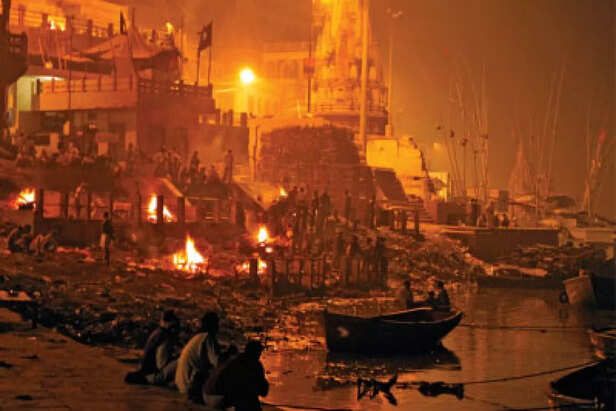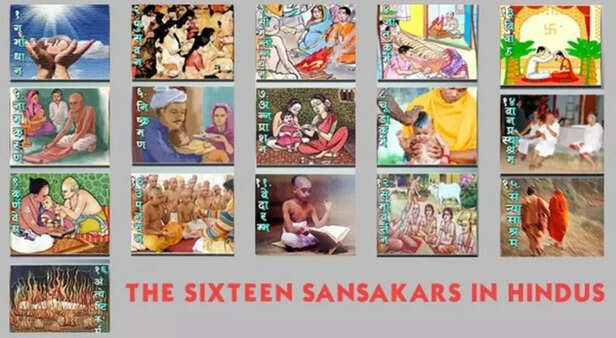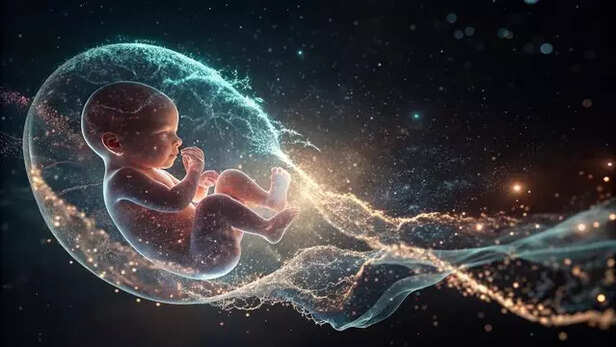Why Babies are Buried, not Cremated in Hindus?
Ankit Gupta | May 06, 2025, 17:15 IST
Baby's Coffin
The Garuda Purana explains that the soul undergoes karmic judgment after death, but children below a certain age are not judged the same way as adults. They are considered to have minimal or no personal karma (Prarabdha Karma). Their death is seen as a result of the parents’ karma, not their own.
Hinduism, one of the world’s oldest and most complex spiritual traditions, embraces a nuanced understanding of life, death, and the journey of the soul. Funeral rites in Hindu culture are deeply symbolic and spiritually significant, designed to facilitate the smooth passage of the soul (ātman) from one plane of existence to another. While adults are customarily cremated, babies and very young children are often buried. This deviation is not merely cultural but has profound metaphysical and scriptural justifications. Among the texts that address death rituals and the afterlife in depth is the Garuda Purana, which provides rich insights into why infants are treated differently in death.

The Garuda Purana, a Vaishnavite text and one of the eighteen Mahāpurāṇas, devotes significant sections to the journey of the soul after death. According to this Purana, the human being is composed of five koshas or sheaths, and the jīva (embodied soul) travels through different planes depending on its karma and spiritual maturity.
When an adult dies, cremation acts as a powerful symbolic and ritualistic means of severing attachments to the body, ego (āhaṁkāra), and the material world. But the Garuda Purana emphasizes that infants, especially those who have not undergone the necessary samskāras (rites of passage), are not bound by karmic consequences in the same way. Their souls are largely untainted by karma, which makes the ritual burning of the ego unnecessary.
Instead, such souls are considered closer to the divine origin, still enveloped in purity. Cremation, with its intense symbolic act of purification through fire, is therefore reserved for those who have accumulated worldly attachments and karmic baggage.

In Hindu dharma, agni (fire) plays a central role as a purifying element. The practice of cremation is based on the belief that burning the body:
Instead, burial symbolizes a gentle return to Prithvi (Earth), one of the five great elements (“pancha mahabhutas”). Earth receives the body lovingly, allowing the pure soul to rest or return without turmoil.

A vital concept in understanding this practice is the role of samskāras. In Hinduism, there are 16 samskāras that mark significant stages in life, from conception to death. These include:
According to the Garuda Purana, the uninitiated child is not subject to Yama’s judgment in the same way as an adult. The soul may rest in subtle realms or even reincarnate within the family, often with the help of divine forces, without undergoing the full karmic audit typical of adults.
The Garuda Purana and traditional Grihya Sutras outline specific guidelines for the death of children:

While fire is purifying, earth is nourishing. In Vedic cosmology, Prithvi is the mother of all beings, and burial represents the infant’s return to her womb. This is not seen as destruction, but as continuation. The pure child, untainted by sin or ego, returns to Mother Earth to be sheltered and perhaps reborn.
In contrast, cremation is an act of severance. It is violent, transformational, and final. It is necessary when the soul must be liberated from deeply ingrained attachments, which babies do not possess.
Some philosophies within Shaivism and Shaktism also regard the burial of pure beings as a way to preserve their spiritual essence, especially if they are believed to be special births or carry siddhis.
In some Tantric traditions, particularly those that work with subtle energies (prana, kundalini), the body of an infant is seen as a highly charged vessel, still vibrating with cosmic innocence. Cremating such a body is viewed as unnecessary or even spiritually insensitive.
Instead, the burial preserves and returns the cosmic vibration gently. Certain regions of India even associate buried children with guardian spirits or ancestral guides, especially if they passed under rare astrological or spiritual circumstances.
Beyond scripture, psychological sensitivity also plays a role in this practice. For grieving parents, burial offers a sense of peace and continuity. Cremation, with its intense fire and destruction, can be emotionally overwhelming when the departed is a baby.
Burial allows a form of memorialization. Trees planted at the burial site, or rituals performed at that spot, offer an ongoing relationship with the soul. In this sense, the ritual becomes not only about the departed but also the living.
It’s worth noting that not all Hindu communities follow the burial practice for infants. In some regions and sects, even children are cremated, especially if they have undergone basic samskāras. Additionally, in modern urban contexts, space and logistics may sometimes override tradition.
However, the spirit of the tradition remains rooted in compassion, purity, and metaphysical sensitivity, all of which are echoed profoundly in the Garuda Purana.
The Hindu funeral system is not a one-size-fits-all model. It adapts according to the soul’s journey, karmic state, and role in the world. The Garuda Purana beautifully illustrates that the rites for babies are different because their souls are different. Not yet burdened by worldly illusions or duties, they return to the Source without needing the fire of transformation.
Burial, then, is not an act of exclusion but of reverence. It acknowledges that the soul of a baby is still shimmering with divinity, requiring no purification, only a gentle farewell.
In this ancient act of returning the infant to Earth rather than Fire, Hinduism showcases its deep intuitive understanding of life and death, one that balances spiritual philosophy with human emotion, scripture with compassion, and ritual with love.
What the Garuda Purana Says About the Soul

The Metaphysical Basis
The Garuda Purana, a Vaishnavite text and one of the eighteen Mahāpurāṇas, devotes significant sections to the journey of the soul after death. According to this Purana, the human being is composed of five koshas or sheaths, and the jīva (embodied soul) travels through different planes depending on its karma and spiritual maturity.
When an adult dies, cremation acts as a powerful symbolic and ritualistic means of severing attachments to the body, ego (āhaṁkāra), and the material world. But the Garuda Purana emphasizes that infants, especially those who have not undergone the necessary samskāras (rites of passage), are not bound by karmic consequences in the same way. Their souls are largely untainted by karma, which makes the ritual burning of the ego unnecessary.
Instead, such souls are considered closer to the divine origin, still enveloped in purity. Cremation, with its intense symbolic act of purification through fire, is therefore reserved for those who have accumulated worldly attachments and karmic baggage.
Cremation: Symbolism and Purpose

Manikarnika Ghat, Varanasi
In Hindu dharma, agni (fire) plays a central role as a purifying element. The practice of cremation is based on the belief that burning the body:
- Destroys residual attachments the soul may have to the physical body.
- Symbolically burns the ego and desires that tether the jīva to samsāra (the cycle of birth and rebirth).
- Assists in the soul’s transition to the Pitrloka (realm of ancestors) or onward to its next birth.
Instead, burial symbolizes a gentle return to Prithvi (Earth), one of the five great elements (“pancha mahabhutas”). Earth receives the body lovingly, allowing the pure soul to rest or return without turmoil.
Samskāras and Their Absence in Infants

A Hindu Way of Life
A vital concept in understanding this practice is the role of samskāras. In Hinduism, there are 16 samskāras that mark significant stages in life, from conception to death. These include:
- Jātakarma (birth ritual)
- Nāmakaraṇa (naming ceremony)
- Annaprāśana (first feeding)
- Vidyārambha (beginning of education)
- Upanayana (initiation into Vedic study)
According to the Garuda Purana, the uninitiated child is not subject to Yama’s judgment in the same way as an adult. The soul may rest in subtle realms or even reincarnate within the family, often with the help of divine forces, without undergoing the full karmic audit typical of adults.
Ritual Procedure for Infant Burial
- Children below a certain age (often 2 or 3, depending on region) are bathed and anointed with sandalwood or turmeric.
- They are adorned with flowers and wrapped in clean, white cloth.
- The body is buried, often under auspicious trees like peepal, neem, or banyan, believed to offer spiritual protection.
- No full-scale Shraddha or Pinda Daan is performed. Instead, a simple prayer or offering may be made to Narayana, asking for the soul’s gentle journey.
Earth as a Womb

Symbolism of Return
While fire is purifying, earth is nourishing. In Vedic cosmology, Prithvi is the mother of all beings, and burial represents the infant’s return to her womb. This is not seen as destruction, but as continuation. The pure child, untainted by sin or ego, returns to Mother Earth to be sheltered and perhaps reborn.
In contrast, cremation is an act of severance. It is violent, transformational, and final. It is necessary when the soul must be liberated from deeply ingrained attachments, which babies do not possess.
Some philosophies within Shaivism and Shaktism also regard the burial of pure beings as a way to preserve their spiritual essence, especially if they are believed to be special births or carry siddhis.
Tantric and Yogic Views
Instead, the burial preserves and returns the cosmic vibration gently. Certain regions of India even associate buried children with guardian spirits or ancestral guides, especially if they passed under rare astrological or spiritual circumstances.
Psychological and Communal Aspects
Burial allows a form of memorialization. Trees planted at the burial site, or rituals performed at that spot, offer an ongoing relationship with the soul. In this sense, the ritual becomes not only about the departed but also the living.
Comparative Note: Exceptions and Regional Variations
However, the spirit of the tradition remains rooted in compassion, purity, and metaphysical sensitivity, all of which are echoed profoundly in the Garuda Purana.
The Wisdom Behind the Exception
Burial, then, is not an act of exclusion but of reverence. It acknowledges that the soul of a baby is still shimmering with divinity, requiring no purification, only a gentle farewell.
In this ancient act of returning the infant to Earth rather than Fire, Hinduism showcases its deep intuitive understanding of life and death, one that balances spiritual philosophy with human emotion, scripture with compassion, and ritual with love.
